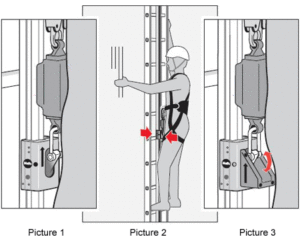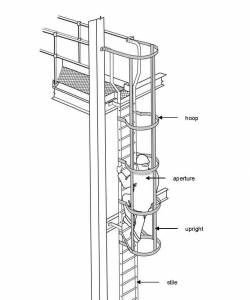Portable Ladder Safety
8 min readLadder
An appliance usually consisting of two side rails joined at regular intervals by cross pieces called steps, rungs, or cleats, on which a person may step when ascending or descending.
Note: All ladders used shall be rated as Type 1A Heavy-duty Industrial Ladders capable of supporting at least 135 kilograms (300 lbs) minimum
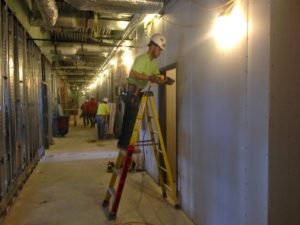
At that article you will be familiar with :
Step Ladder
A self-supporting portable ladder, nonadjustable in length, having flat steps and a hinged back. Its size (length) is designated by the overall length of the ladder measured along the front edge of the side rails.
Note: Step ladders exceeding 6 meters (20 ft) are not permitted.
Extension Ladder 

A non self-supporting portable ladder adjustable in length. It consists of two or more sections traveling in guides or brackets so arranged to permit length adjustment. Its size is designated by the sum of the lengths of sections measured along the side rails.
Sectional Ladder

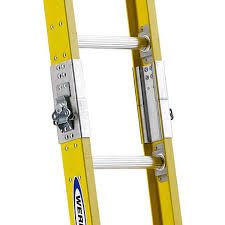
A self-supporting ladder, non adjustable in length, consisting of two or more sections of ladder constructed so that the sections may be combined to function as a single ladder. Its size is designated by the overall length of the assembled sections.
Single Ladder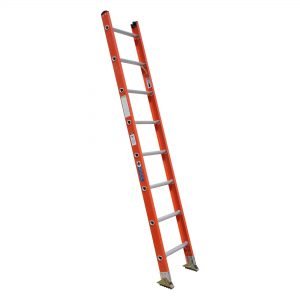
A non self-supporting portable ladder, non adjustable in length, consisting of one section. Its size is designated by the overall length of the side rails.
Side-Rolling Ladder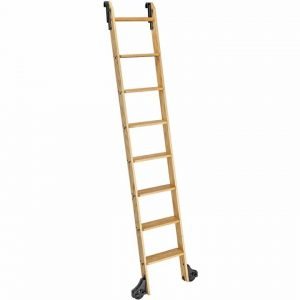
A semi-fixed ladder, non adjustable in length, supported to attachments by a guide rail that is generally fastened to shelving, the plane of the ladder also being its plane of motion.
Trestle Ladder

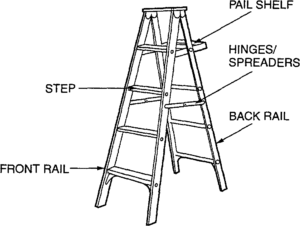
A self-supporting portable ladder, non adjustable in length, consisting of two sections hinged at the top to form equal angles at the base. The size is designated by the length of the side rails measured along the front edge.
Extension Trestle Ladder

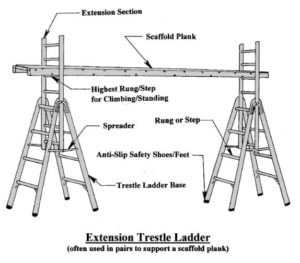
A self-supporting portable ladder adjustable in length, consisting of a trestle ladder base and a vertically adjustable single ladder, with suitable means for locking the ladders together. The size is designated by the trestle ladder base.
Trolley ladder


A semi fixed ladder, non adjustable in length, supported by attachments to a track, the plane of the ladder being at right angles to the plane of motion.
Portable Ladder Safety
- The following types of ladders shall not be supplied at HSSE world Projects:
- Wood stepladders longer than 6.09 meters (20 ft).
- Wood single ladders longer than 9.14 meters (30 ft).
- Wood extension ladders (two section) longer than 18.28 meters (60 ft).
- Trestle ladders longer than 6.09 meters (20 ft).
- Trolley and side rolling ladders longer than 6.09 meters (20 ft).
- Metal platform ladders longer than 6.09 meters (20 ft).
- Metal extension ladders (two-section metal) longer than 14 63 meters (48 ft).
- Metal extension ladders (three-section) longer than 18.28 meters (60 ft).
- No ladder rated less than Type 1A (136 Kg (300 lb) is permitted.
- Ladders are the only acceptable means of access to elevated areas where properly constructed stairs are not provided. Step ladders shall not normally be used for repeated access to elevated locations. Exceptions to this is the use of step ladders to access floats and tractor trailers if they are placed adjacent to the trailer and secured to prevent falling over.
- Basic Ladder Safety

- Absolutely no objects, tools, or material are allowed to be carried in hands while ascending or descending ladders. Feet shall be free of mud, grease or other substances that could cause a slip.
- Ladders with broken or missing steps, rungs, or cleats, broken side rails, or other faulty equipment shall be removed from service and tagged “Defective – Do Not Use”.
- When ascending, working from, or descending a ladder, personnel shall face the ladder and have both hands free for climbing. When working from a ladder, personnel shall maintain 3-point contact at all times and shall not lean past the side rails to reach the work (Belt buckle shall remain between ladder side rails). The ladder shall be moved to avoid overreaching.


- Personnel shall not carry tools and materials in their hands while climbing ladders, a hoist line shall be used.
- When working 1.8 meters (6 ft) or more off the ground or continuous floor surface, a fall protection system shall be employed.
 Self-retracting lanyards/life lines shall be placed above every temporary construction ladder that is to be used for repeated access/egress and exposes employees to a fall hazard greater than 3 meters (10 ft).Portable ladders used for access to an elevation to perform a single task do not require a self-retracting lanyard. Note: The 3 meter designation refers to the height of the working platform/ladder rung above a lower level and/or the position of the person’s feet above the lower level, i.e.:
Self-retracting lanyards/life lines shall be placed above every temporary construction ladder that is to be used for repeated access/egress and exposes employees to a fall hazard greater than 3 meters (10 ft).Portable ladders used for access to an elevation to perform a single task do not require a self-retracting lanyard. Note: The 3 meter designation refers to the height of the working platform/ladder rung above a lower level and/or the position of the person’s feet above the lower level, i.e.:- If the ladder leading to a work platform creates a condition where an person climbs 3 meters or greater (measured from the person’s feet) or the rung on which work is being performed is 3 meters or greater, the ladder shall be equipped with a ladder cage or other supplemental fall protection device.
- If the ladder leading to a work platform or the ladder rung on which work is being performed is less than 3 meters in height, supplemental fall protection is not required.



- If using self-retracting lanyards/lifelines, the following guidelines shall
be followed:
- The lanyard/lifeline reels shall be secured above the highest point of access.
- Personnel using these ladders shall secure the self-retracting lanyard/lifeline to their harness while ascending or descending the ladder.
- A retrieval line long enough to reach the bottom of the ladder when the line is fully retracted shall be attached to the hook.
- One self-retracting lanyard/lifeline shall be provided for personnel ascending or descending the temporary ladder.
- Adequate anchor points for self-retracting lanyard/lifeline devices must meet fall protection manufacturer recommendations.
- If the self-retracting lanyard/lifeline device is anchored to a scaffold, the attachment point must be certified by the scaffold manufacturer.
- Ladders shall not be used horizontally as walkways or as makeshift scaffolds.
- Ladders with rungs or steps on the front side only shall not be used by more than one employee at a time. Where use by more than one person is anticipated, specially designed ladders with rungs or steps on both front and back side shall be provided.
- Portable ladders shall be placed so that the side rails have a secure level footing. The top rest for portable rung and cleat ladders shall be reasonably rigid and shall have ample strength to support the applied load.
- Straight ladders shall be placed so that the bottom of the ladder is ¼ the ladder’s working length out from the top support. The ladder shall be secured at the top support.
- While erecting a straight ladder, one worker shall hold the bottom of the ladder while another worker climbs to its top support.
- When the top support is reached, the worker shall secure his full-body harness lanyard to a suitable anchorage and then secure the ladder. A hoist line is used to lift any tools/materials.
Note: Lanyards shall never be secured to a portable ladder. The above steps are worked in reverse order when the task is completed, with the workers full-body harness being the last item disconnected before descent.
- Ladders shall not be placed in front of doors opening toward the ladder unless the door is blocked, locked, or guarded.
- Ladders shall not be placed on boxes, barrels, or other unstable bases to obtain additional height, nor shall they be placed against movable objects.
- Short ladders shall not be spliced together to provide longer sections nor be used as guys, braces, or skids, or for other than their intended purpose.
- Personnel shall not use the top 3 steps of a step ladder. The back leg braces of step ladders are solely for increasing stability and not for use of climbing. Step ladders shall not be used as straight ladders.Legs of step ladders shall be fully spread with locks fully engaged. Tools and materials shall not be placed on the top step of the ladder.
- On two section extension ladders, the minimum overlap for the two sections in use shall be as follows:
Size of ladder (feet)
Overlap (feet)
Up to and including 36 3 Over 36 and including 48 4 Over 48 and including 60 5 - Extension ladders shall not be separated to make single ladders.
- Portable rung ladders with reinforced rails shall be used only with the metal reinforcement on the under side. No ladder shall be used to gain access to a roof or platform unless the top of the ladder extends at least 1 meter (3 ft) above the upper point of support.
- Only wooden or fiberglass ladders shall be permitted when there is a potential of electrical shock hazards
- Portable ladders shall be fitted with safety “feet” when the hazard of slipping is possible. Non-slip bases are not intended as a substitute for care in safely placing, lashing, or holding a ladder that is being used on metal, concrete, or slippery surfaces. When used on grating or similar surfaces having perforations, ladders shall be equipped with extra-wide safety “feet” that cannot slip through spaces.
- The areas around the top and base of ladders must be free of tripping hazards such as loose materials, trash and electric cords.
- Splice a 13 millimeter (0.5 in) minimum rope (nylon, Dacron®, or polypropylene, depending on environmental exposure) to the top back rung of step ladders, 2.4 meters (8 ft) tall or taller and/or to the third rung from the top of straight or extension ladders to provide a tie-off rope when the ladder is set-up.
- Frequent Inspections
- Ladders shall be inspected daily and prior to each use by the user to ensure that they are in proper working order.
- Ladders shall be inspected each month by a designated Competent Person. Monthly ladder inspections shall be documented and
inspected ladders shall be provided with a color-code inspection verification (Use Portable Ladder self inspection checklist Here). - Ladder users shall ensure that color code markings remain legible between inspections. Ladders with illegible inspection verifications shall be considered unsafe and shall be removed from service.
- Damaged or defective ladders must be tagged “Defective – Do NotUse” and removed from service immediately.
- Under no circumstances shall ladders in need of inspection or repair remain in service.
Maintenance
- Ladders shall be maintained in good condition at all times. The joint between the steps and side rails shall be tight, all hardware and fittings securely attached, and the movable parts shall operate freely without binding or undue play.
- Metal bearings of locks, wheels, pulleys, etc., shall be frequently lubricated.
- Frayed or badly worn rope shall be replaced.
- Safety feet and other auxiliary equipment shall be kept in good condition to insure proper performance. Rungs shall be kept free of grease and oil.
- If a ladder falls, it shall be inspected for side rail dents or bends, excessively dented rungs, loose rung to side rail connections, hardware connections, and rivets for shear.
- Ladders shall not be modified from their original design, nor used for other than their originally designed purpose.
Construction Requirments
- Manufactured ladders shall be approved in accordance with the appropriate ANSI Standard. Ladders shall not be modified from their original design.
- Job-made ladders shall be constructed from all wood parts and shall be free from sharp edges, splinters, shake, wane, compression failures, decay, or other irregularities. All job-made ladders shall be approved by the HSE Manager prior to use.
- . Uniform step spacing shall be not more than 12 inches. Steps shall be level when the ladder is in position for use.



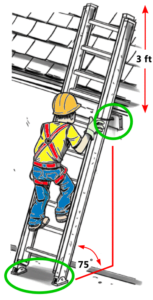
 Self-retracting lanyards/life lines shall be placed above every temporary construction ladder that is to be used for repeated access/egress and exposes employees to a fall hazard greater than 3 meters (10 ft).Portable ladders used for access to an elevation to perform a single task do not require a self-retracting lanyard. Note: The 3 meter designation refers to the height of the working platform/ladder rung above a lower level and/or the position of the person’s feet above the lower level, i.e.:
Self-retracting lanyards/life lines shall be placed above every temporary construction ladder that is to be used for repeated access/egress and exposes employees to a fall hazard greater than 3 meters (10 ft).Portable ladders used for access to an elevation to perform a single task do not require a self-retracting lanyard. Note: The 3 meter designation refers to the height of the working platform/ladder rung above a lower level and/or the position of the person’s feet above the lower level, i.e.: